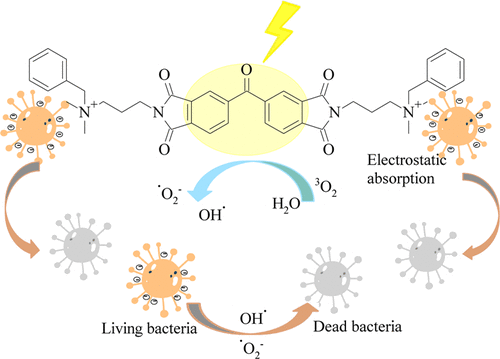当前位置:
X-MOL 学术
›
ACS Appl. Mater. Interfaces
›
论文详情
Our official English website, www.x-mol.net, welcomes your
feedback! (Note: you will need to create a separate account there.)
Light-Induced Production of Reactive Oxygen Species by a Novel Water-Soluble Benzophenone Derivative Containing Quaternary Ammonium Groups and Its Assembly on the Protein Fiber Surface.
ACS Applied Materials & Interfaces ( IF 8.3 ) Pub Date : 2019-07-08 , DOI: 10.1021/acsami.9b07992 Liu Hu , Aiqin Hou , Kongliang Xie , Aiqin Gao
ACS Applied Materials & Interfaces ( IF 8.3 ) Pub Date : 2019-07-08 , DOI: 10.1021/acsami.9b07992 Liu Hu , Aiqin Hou , Kongliang Xie , Aiqin Gao

|
Developing an efficient antimicrobial surface has important significance in the field of advanced biomaterials. A novel water-soluble benzophenone tetracarboxylamine derivative containing two quaternary ammonium groups, 3,3'-[4,4'-carbonyl-diphthalimide-]-bis(N-benzyl-N,N-dimethyl-N-propyl-1-aminium)dichloride (BPTCA-N), as a photoactive antibacterial agent was designed and synthesized. The ability of BPTCA-N to generate reactive oxygen species (ROS) in solution was investigated by light-induced activity. Its antibacterial activity in a dark environment or UV exposure was tested on Staphylococcus aureus and Escherichia coli. The influences of different solvents and the pH values on the ability of BPTCA-N to generate ROS were also discussed. BPTCA-N possessed high photoactivity and efficient ROS generation ability. The generation of hydroxyl radicals could be greatly affected by addition of other solvents and H+ or OH-. For the BPTCA-N solution at a concentration of 0.2 mmol/L, the reduction of S. aureus and E. coli could all reach 99.99%. The BPTCA-N compound was assembled onto wool protein fibers. The modified protein fabrics also showed excellent photoactivity and antibacterial property against S. aureus and E. coli. For the wool fabric modified with 30 g/L of BPTCA-N, the reduction of S. aureus could reach 99.91% and that of E. coli was 91.23%. BPTCA-N had the synergistic antibacterial effect of quaternary ammonium salt and benzophenones. It has potential application in the biomedical field as highly effective antimicrobial agent or antimicrobial biomaterial.
中文翻译:

一种新型的含有季铵基团的水溶性二苯甲酮衍生物的光诱导活性氧的生产及其在蛋白质纤维表面的组装。
在先进的生物材料领域,开发有效的抗菌表面具有重要意义。一种新颖的水溶性二苯甲酮四羧胺衍生物,含有两个季铵基团3,3'-[4,4'-羰基-二邻苯二甲酰亚胺-]-双(N-苄基-N,N-二甲基-N-丙基-1-铵设计合成了二氯化物(BPTCA-N)作为光活性抗菌剂。通过光诱导活性研究了BPTCA-N在溶液中产生活性氧(ROS)的能力。在金黄色葡萄球菌和大肠杆菌中测试了其在黑暗环境或紫外线照射下的抗菌活性。还讨论了不同溶剂和pH值对BPTCA-N产生ROS的能力的影响。BPTCA-N具有较高的光活性和有效的ROS生成能力。加入其他溶剂和H +或OH-会极大地影响羟基自由基的产生。对于浓度为0.2 mmol / L的BPTCA-N溶液,金黄色葡萄球菌和大肠杆菌的还原率均可达到99.99%。将BPTCA-N化合物组装到羊毛蛋白纤维上。改性的蛋白质织物还显示出优异的对金黄色葡萄球菌和大肠杆菌的光活性和抗菌性能。对于用30 g / L的BPTCA-N改性的羊毛织物,金黄色葡萄球菌的减少率可以达到99.91%,而大肠杆菌的减少率可以达到91.23%。BPTCA-N具有季铵盐和二苯甲酮的协同抗菌作用。它作为高效抗菌剂或抗菌生物材料在生物医学领域具有潜在的应用。对于浓度为0.2 mmol / L的BPTCA-N溶液,金黄色葡萄球菌和大肠杆菌的还原率均可达到99.99%。将BPTCA-N化合物组装到羊毛蛋白纤维上。改性的蛋白质织物还显示出优异的对金黄色葡萄球菌和大肠杆菌的光活性和抗菌性能。对于用30 g / L的BPTCA-N改性的羊毛织物,金黄色葡萄球菌的减少率可以达到99.91%,而大肠杆菌的减少率可以达到91.23%。BPTCA-N具有季铵盐和二苯甲酮的协同抗菌作用。它作为高效抗菌剂或抗菌生物材料在生物医学领域具有潜在的应用。对于浓度为0.2 mmol / L的BPTCA-N溶液,金黄色葡萄球菌和大肠杆菌的还原率均可达到99.99%。将BPTCA-N化合物组装到羊毛蛋白纤维上。改性的蛋白质织物还显示出优异的对金黄色葡萄球菌和大肠杆菌的光活性和抗菌性能。对于用30 g / L的BPTCA-N改性的羊毛织物,金黄色葡萄球菌的减少率可以达到99.91%,而大肠杆菌的减少率可以达到91.23%。BPTCA-N具有季铵盐和二苯甲酮的协同抗菌作用。它作为高效抗菌剂或抗菌生物材料在生物医学领域具有潜在的应用。改性的蛋白质织物还显示出优异的对金黄色葡萄球菌和大肠杆菌的光活性和抗菌性能。对于用30 g / L的BPTCA-N改性的羊毛织物,金黄色葡萄球菌的减少率可以达到99.91%,而大肠杆菌的减少率可以达到91.23%。BPTCA-N具有季铵盐和二苯甲酮的协同抗菌作用。它作为高效抗菌剂或抗菌生物材料在生物医学领域具有潜在的应用。改性的蛋白质织物还显示出优异的对金黄色葡萄球菌和大肠杆菌的光活性和抗菌性能。对于用30 g / L的BPTCA-N改性的羊毛织物,金黄色葡萄球菌的减少率可以达到99.91%,而大肠杆菌的减少率可以达到91.23%。BPTCA-N具有季铵盐和二苯甲酮的协同抗菌作用。它作为高效抗菌剂或抗菌生物材料在生物医学领域具有潜在的应用。
更新日期:2019-06-26
中文翻译:

一种新型的含有季铵基团的水溶性二苯甲酮衍生物的光诱导活性氧的生产及其在蛋白质纤维表面的组装。
在先进的生物材料领域,开发有效的抗菌表面具有重要意义。一种新颖的水溶性二苯甲酮四羧胺衍生物,含有两个季铵基团3,3'-[4,4'-羰基-二邻苯二甲酰亚胺-]-双(N-苄基-N,N-二甲基-N-丙基-1-铵设计合成了二氯化物(BPTCA-N)作为光活性抗菌剂。通过光诱导活性研究了BPTCA-N在溶液中产生活性氧(ROS)的能力。在金黄色葡萄球菌和大肠杆菌中测试了其在黑暗环境或紫外线照射下的抗菌活性。还讨论了不同溶剂和pH值对BPTCA-N产生ROS的能力的影响。BPTCA-N具有较高的光活性和有效的ROS生成能力。加入其他溶剂和H +或OH-会极大地影响羟基自由基的产生。对于浓度为0.2 mmol / L的BPTCA-N溶液,金黄色葡萄球菌和大肠杆菌的还原率均可达到99.99%。将BPTCA-N化合物组装到羊毛蛋白纤维上。改性的蛋白质织物还显示出优异的对金黄色葡萄球菌和大肠杆菌的光活性和抗菌性能。对于用30 g / L的BPTCA-N改性的羊毛织物,金黄色葡萄球菌的减少率可以达到99.91%,而大肠杆菌的减少率可以达到91.23%。BPTCA-N具有季铵盐和二苯甲酮的协同抗菌作用。它作为高效抗菌剂或抗菌生物材料在生物医学领域具有潜在的应用。对于浓度为0.2 mmol / L的BPTCA-N溶液,金黄色葡萄球菌和大肠杆菌的还原率均可达到99.99%。将BPTCA-N化合物组装到羊毛蛋白纤维上。改性的蛋白质织物还显示出优异的对金黄色葡萄球菌和大肠杆菌的光活性和抗菌性能。对于用30 g / L的BPTCA-N改性的羊毛织物,金黄色葡萄球菌的减少率可以达到99.91%,而大肠杆菌的减少率可以达到91.23%。BPTCA-N具有季铵盐和二苯甲酮的协同抗菌作用。它作为高效抗菌剂或抗菌生物材料在生物医学领域具有潜在的应用。对于浓度为0.2 mmol / L的BPTCA-N溶液,金黄色葡萄球菌和大肠杆菌的还原率均可达到99.99%。将BPTCA-N化合物组装到羊毛蛋白纤维上。改性的蛋白质织物还显示出优异的对金黄色葡萄球菌和大肠杆菌的光活性和抗菌性能。对于用30 g / L的BPTCA-N改性的羊毛织物,金黄色葡萄球菌的减少率可以达到99.91%,而大肠杆菌的减少率可以达到91.23%。BPTCA-N具有季铵盐和二苯甲酮的协同抗菌作用。它作为高效抗菌剂或抗菌生物材料在生物医学领域具有潜在的应用。改性的蛋白质织物还显示出优异的对金黄色葡萄球菌和大肠杆菌的光活性和抗菌性能。对于用30 g / L的BPTCA-N改性的羊毛织物,金黄色葡萄球菌的减少率可以达到99.91%,而大肠杆菌的减少率可以达到91.23%。BPTCA-N具有季铵盐和二苯甲酮的协同抗菌作用。它作为高效抗菌剂或抗菌生物材料在生物医学领域具有潜在的应用。改性的蛋白质织物还显示出优异的对金黄色葡萄球菌和大肠杆菌的光活性和抗菌性能。对于用30 g / L的BPTCA-N改性的羊毛织物,金黄色葡萄球菌的减少率可以达到99.91%,而大肠杆菌的减少率可以达到91.23%。BPTCA-N具有季铵盐和二苯甲酮的协同抗菌作用。它作为高效抗菌剂或抗菌生物材料在生物医学领域具有潜在的应用。















































 京公网安备 11010802027423号
京公网安备 11010802027423号